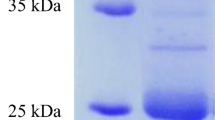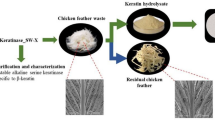Abstract
Bacteria from Patagonian Merino wool were isolated to assess their wool-keratinolytic activity and potential for felt-resist treatments. Strains from Bacillus, Exiguobacterium, Deinococcus, and Micrococcus produced wool-degrading enzymes. Bacillus sp. G51 showed the highest wool-keratinolytic activity. LC-MS/MS analysis revealed that G51 secreted two serine proteases belonging to the peptidase family S8 (MEROPS) and a metalloprotease associated with Bacillolysin, along with other enzymes (γ-glutamyltranspeptidase and dihydrolipoyl dehydrogenases) that could be involved in reduction of keratin disulfide bonds. Optimum pH and temperature of G51 proteolytic activity were 9 and 60 °C, respectively. More than 80% of activity was retained in H2O2, Triton X-100, Tween 20, Lipocol OXO650, Teridol B, and β-mercaptoethanol. Treatment of wool top with G51 enzyme extract caused a decrease in wool felting tendency without significant weight loss (<1.5%). Sparse work has so far been performed to investigate suitable keratinases for the organic wool sector. This eco-friendly treatment based on a new enzyme combination produced by a wild bacterium has potential for meeting the demands of organic wool processing which bans the use of hazardous chemicals and genetic engineering.




Similar content being viewed by others
References
Plowman JE, Deb-Choudhury S, Clerens S, Thomas A, Cornellison CD, Dyer JM (2012) Unravelling the proteome of wool: towards markers of wool quality traits. J Proteomics 75:4315–4324
Fu J, Su J, Wang P, Yu Y, Wang Q, Cavaco-Paulo A (2015) Enzymatic processing of protein-based fibers. Appl Microbiol Biotechnol 99:10387–10397
Shen J (2009) In: Johnson NAG, Russell IM (eds) Advances in wool technology, 1st edn. Woodhead Publishing in Textiles, Cambridge
Holt RRD (1975) Introduction to Superwash wool. JSDC February: 38–44.
Buschle-Diller G (2003) In: Cavaco-Paulo A, Gübitz GM (eds) Textile processing with enzymes, 1st edn. Woodhead Publishing Ltd, Cambridge.
Ladwig H, Stopes C, Arbenz M, Lernoud J (2015) Organic opportunities and challenges: the next generation of the wool industry. In: Global Organic Textile Standart (GOTS). http://www.global-standard.org/images/stories/Why_GOTS_Factsheets/GOTS_WoolPoster_June2015_low.pdf. Accessed 25 Nov 2016
GOTS (2014) Version 4.0 Global Organic Textile Standard International Working Group. http://global-standard.org/the-standard.html. Accessed 25 Nov 2016
Shen J (2010) In: Nierstrasz VA, Cavaco-Paulo A (eds) Advances in textile biotechnology, 1st edn. Woodhead Publishing in Textiles. Cambridge
Cegarra J, Pepió M, Naik A, Riva A (2004) Modelización de la acción de una proteasa en las características físicas de un tejido de lana. Boletín Intexter (UPC) 125:9–18.
Kotlińska A, Lipp-Symonowicz B (2011) Research on the enzymatic treatment of wool fibres and changes in selected properties of wool. Fibres Text East Eur 19:88–93.
Lenting HBM, Schroeder M, Guebitz GM, Cavaco-Paulo A, Shen J (2006) New enzyme-based process direction to prevent wool shrinking without substantial tensile strength loss. Biotechnol Lett 28:711–716
Araújo R, Silva C, Machado R, Casal M, Cunha AM, Rodriguez-Cabello JC, Cavaco-Paulo A (2009) Proteolytic enzyme engineering: a tool for wool. Biomacromolecules 10:1655–1661
Shen J, Rushforth M, Cavaco-Paulo A, Guebitz G, Lenting H (2007) Development and industrialisation of enzymatic shrink-resist process based on modified proteases for wool machine washability. Enzyme Microb Technol 40:1656–1661
Silva CJSM, Prabaharan M, Gubitz G, Cavaco-Paulo A (2005) Treatment of wool fibres with subtilisin and subtilisin-PEG. Enzyme Microb Technol 36:917–922
Liu B, Zhang J, **angru-Liao BL, Du G, Chen J (2013) Expression and characterization of extreme alkaline, oxidation-resistant keratinase from Bacillus licheniformis in recombinant Bacillus subtilis WB600 expression system and its application in wool fiber processing. World J Microbiol Biotechnol 29:825–832
HERA (2007) Human and environmental risk assessment on ingredients of household cleaning products. Subtilisins (Protease). http://www.heraproject.com/files/22-F-07_PROTEASE_HERA_Final%20Edition%20(unsecured%20-%20PDFA-1b).pdf. Accessed 25 Nov 2016
Hayakawa M, Nonomura H (1987) Humic acid-vitamin agar, a new medium for the selective isolation of soil actinomycetes. J Ferment Technol 65:501–509
Sousa F, Jus S, Erbel A, Kokol V, Cavaco-Paulo A, Gubitz GM (2007) A novel metalloprotease from Bacillus cereus for protein fibre processing. Enzyme Microb Technol 40:1772–1781
Queiroga AC, Pintado MM, Malcata FX (2007) Novel microbial-mediated modifications of wool. Enzyme Microb Technol 40:1491–1495
Olivera N, Siñeriz F, Breccia JD (2005) Bacillus patagoniensis sp. nov., a novel alkalitolerant bacterium from the rhizosphere of Atriplex lampa in Patagonia, Argentina. Int J Syst Evol Microbiol 55:443–447
Kim OS, Cho YJ, Lee K, Yoon SH, Kim M, Na H, Park SC, Jeon YS, Lee JH, Yi H, Won S, Chun J (2012) Introducing EzTaxon-e: a prokaryotic 16 S rRNA gene sequence database with phylotypes that represent uncultured species. Int J Syst Evol Microbiol 62:716–721
Moreira FG, De Souza CGM, Costa MAF, Reis S, Peralta RM (2007) Degradation of keratinous materials by the plant pathogenic fungus Myrothecium verrucaria. Mycopathologia 163:153–160
Cupp-Enyard C (2008) Sigma’s non-specific protease activity assay—casein as a substrate. J Vis Exp 19:899
Good NE, Izawa S (1972) Hydrogen ion buffers. Methods Enzymol 24:53–68
Neuhoff V, Stamm R, Pardowitz I, Arold N, Ehrhardt W, Taube D (1990) Essential problems in quantification of proteins following colloidal staining with Coomassie Brilliant Blue dyes in polyacrylamide gels, and their solution. Electrophoresis 11:101–117
Westergaard JL, Hackbarth C, Treuhaft MW, Roberts RC (1980) Detection of proteinases in electrophoretograms of complex mixtures. J Immunol Methods 34:167–175
Kenyon PR, Wickham GA (1999) A New technique for measuring loose-wool feltability. J Text Inst 90:266–268
Norušis MJ (1997) SPSS 7.5 Guide to Data Analysis. Prentice Hall, New Jersey
Infante I, Morel MA, Ubalde MC, Martínez-Rosales C, Belvisi S, Castro-Sowinski S (2010) Wool-degrading Bacillus isolates: extracellular protease production for microbial processing of fabrics. World J Microbiol Biotechnol 26:1047–1052
Haddar A, Sellami-Kamoun A, Fakhfakh-Zouari N, Hmidet N, Nasri M (2010) Characterization of detergent stable and feather degrading serine proteases from Bacillus mojavensis A21. Biochem Eng J 51:53–63
Hassan MA, Haroun BM, Amara AA, Serour EA (2013) Production and characterization of keratinolytic protease from new wool-degrading Bacillus species isolated from Egyptian ecosystem. BioMed Res Int 2013:1–14.
Lee DG, Jeon JH, Jang MK, Kim NY, Lee JH, Lee JH, Kim SJ, Kim GD, Lee SH (2007) Screening and characterization of a novel fibrinolytic metalloprotease from a metagenomic library. Biotechnol Lett 29:465–472
Ibrahim NA, El-Shafei HA, Abdel-Aziz MS, Ghaly MF, Eid BM, Hamed AA (2012) The potential use of alkaline protease from Streptomyces albidoflavus as an eco-friendly wool modifier. J Text Inst 103:490–498
Daroit DJ, Brandelli A (2013) A current assessment on the production of bacterial keratinases. Crit Rev Biotechnol 34:372–384
Lange L, Huang Y, Busk PK (2016) Microbial decomposition of keratin in nature—a new hypothesis of industrial relevance. Appl Microbiol Biotechnol 100:2083–2096
Evans KL, Crowder J, Miller ES (2000) Subtilisins of Bacillus spp. hydrolyze keratin and allow growth on feathers. Can J Microbiol 46:1004–1011
Ramnani P, Gupta R (2007) Keratinases vis-à-vis conventional proteases and feather degradation. World J Microbiol Biotechnol 23:1537–1540
Brandelli A, Daroit DJ, Riffel A (2010) Biochemical features of microbial keratinases and their production and applications. Appl Microbio Biotechnol 85:1735–1750
Gupta R, Sharma R, Beg QK (2012) Revisiting microbial keratinases: next generation proteases for sustainable biotechnology. Crit Rev Biotechnol 30:1–13
Liu Q, Zhang T, Song N, Li Q, Wang Z, Zhang X, Lu X, Fang J, Chen J (2014) Purification and characterization of four key enzymes from a feather-degrading Bacillus subtilis from the gut of tarantula Chilobrachys guangxiensis. Int Biodeter Biodegrad 96:26–32.
Rahayu S, Syah D, Suhartono MT (2012) Degradation of keratin by keratinase and disulfide reductase from Bacillus sp. MTS of Indonesian origin. Biocatal Agric Biotechnol 1:152–158.
Sharma R, Gupta R (2012) Coupled action of γ-glutamyl transpeptidase-glutathione and keratinase effectively degrades feather keratin and surrogate prion protein, Sup 35NM. Bioresour Technol 120:314–317
Tiwary E, Gupta R (2010) Improved catalytic efficiency of a monomeric γ-glutamyl transpeptidase from Bacillus licheniformis in presence of subtilisin. Biotechnol Lett 32:1137–1141
Tiwary E, Gupta R (2010) Subtilisin-γ-glutamyl transpeptidase: a novel combination as ungual enhancer for prospective topical application. J Pharma Sci 99:4866–4873
Chaya E, Suzuki T, Karita S, Hanya A, Yoshino-Yasuda S, Kitamoto N (2014) Sequence analysis and heterologous expression of the wool cuticle-degrading enzyme encoding genes in Fusarium oxysporum 26–1. J Biosci Bioeng 117:711–714
Fang Z, Zhang J, Liu B, Du G, Chen J (2013) Biochemical characterization of three keratinolytic enzymes from Stenotrophomonas maltophilia BBE11-1 for biodegrading keratin wastes. Int Biodeter Biodegrad 82:166–172.
Greeff JC, Schlink AC (2002) The inheritance of felting of merino wool. Proc Assoc Advmt Anim Breed Genet 14:497–500.
Allam OG, Mowafi S, El-kheir AA, Abdel-fattah AM, Bendak A (2015) Effect of extracted Egyptian keratinase on the properties of native coarse wool. Int J Adv Res 3:994–1003
Jus S, Schroeder M, Guebitz GM, Heine E, Kokol V (2007) The influence of enzymatic treatment on wool fibre properties using PEG-modified proteases. Enzyme Microb Technol 40:1705–1171
Jovančić P, Jocić D, Dumić J (1998) The efficiency of an enzyme treatment in reducing wool shrinkage. J Text Inst 89:390–400
Acknowledgements
The authors acknowledge to Fuhrmann S.A. for kindly providing wool tops and to UNILAN Trelew S.A., Lanera Austral S.A., Estancia San Guillermo, and Estancia Don Martín for raw wool samples. The authors are also grateful to Jaime Groizard (ALUAR Aluminio Argentino) for scanning electron micrographs. This work was supported by the Agencia Nacional de Promoción Científica y Tecnológica (ANPCyT), Ministerio de Ciencia, Tecnología e Innovación Productiva, Argentina (PICT Start Up 2012–2004); and the Consejo Nacional de Investigaciones Científicas y Técnicas (CONICET), Argentina (PIP 11220120100050CO). Martín Iglesias is grateful to ANPCyT for his Ph.D. grant.
Author information
Authors and Affiliations
Corresponding author
Ethics declarations
Conflict of interest
No conflict of interest declared.
Electronic supplementary material
Below is the link to the electronic supplementary material.
Rights and permissions
About this article
Cite this article
Iglesias, M.S., Sequeiros, C., García, S. et al. Newly isolated Bacillus sp. G51 from Patagonian wool produces an enzyme combination suitable for felt-resist treatments of organic wool. Bioprocess Biosyst Eng 40, 833–842 (2017). https://doi.org/10.1007/s00449-017-1748-4
Received:
Accepted:
Published:
Issue Date:
DOI: https://doi.org/10.1007/s00449-017-1748-4




